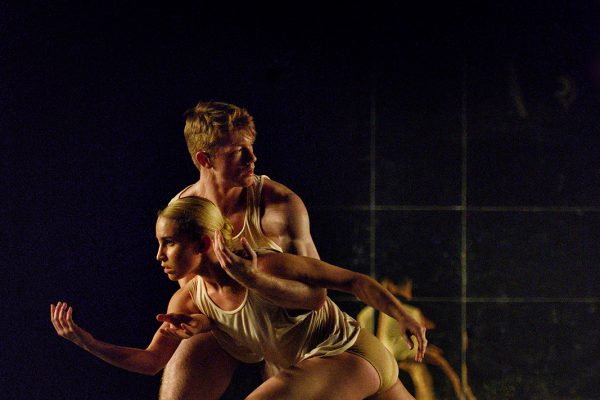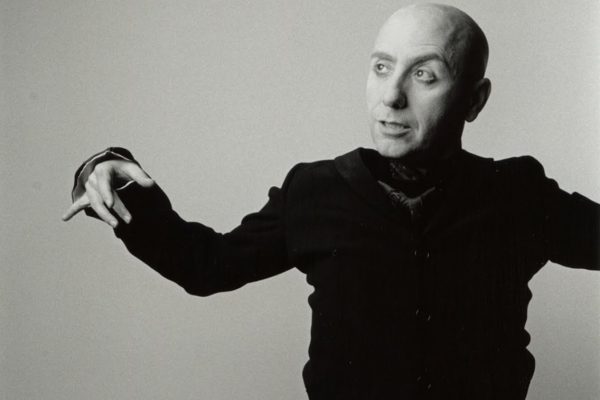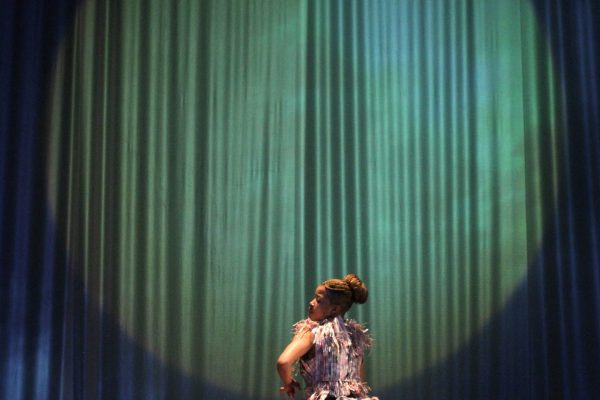KP: It was a bit of an occasion to have Toronto-based Karen and Allen Kaeja premiere their “Abattoir” here in Vancouver at the Norman Rothstein Theatre. Three presenters came on board to support it: Chutzpah! International Showcase of Jewish Performing Arts, the Vancouver 2010 Cultural Olympiad and the Vancouver International Dance Festival (VIDF). While the opening night house was hardly full, that may partly have been because EDAM — who like Kaeja d’Dance has contact improvisation at its base — was premiering artistic director Peter Bingham’s “The Vargas Project” at the Roundhouse Community Centre as part of the VIDF that same evening.
The Kaejas do something quite different than Bingham, judging from the few works of theirs I’ve seen, which have had a clear sense of drama and tackled tough themes, including the Holocaust. There is also a harder edge to the Kaejas’ choreography. All this was certainly the case with “Abattoir”, not surprisingly in a work about a slaughterhouse. It’s a sobering sixty-odd minutes — although there’s enough compelling movement suggesting the urgency and beauty of life to keep “Abattoir” from being as depressing as its theme of animal slaughter might suggest.
Now that you’ve seen the work in Toronto at the Premiere Dance Theatre, Megan, would you agree there is beauty present despite its troubling subject matter?
MA: Absolutely. I was surprisingly engaged in a way that I haven’t been with various past works by the company. This work has a dense texture; in his program note, Allen Kaeja says that “a poetic life inhabits the journey of “Abattoir”, and I think this is true. Allen attributes it to the text by Jason Sherman and perhaps that is indeed a part of the work’s strength but the poetry, for me, comes in the way the movement imagery and the text pulse between the personal story of Allen’s youth working with his brothers in the family’s abattoir and the mytho-religious resonances with the biblical story of Jacob, who led the Israelites out of slavery in Egypt and the significance of the blood of the sacrificial lamb in that narrative.
The line of text, “And Friday come the lambs”, which repeated throughout the work, carried the metaphor, and a political tone also wove through in the way the dancers transformed at various times from people into herding animals — cattle or sheep. I was strongly reminded of Kaeja d’Dance’s earlier themes including, as you mention above, the Holocaust. Potent material deftly conveyed, if a bit overt at times for my taste. Did these tones resonate for you in the Vancouver premiere?
KP: Yes, they did, but I didn’t recall anything specific about Jacob — I’m no biblical scholar, unfortunately. Still, the name worked for me in general terms by suggesting larger mythic proportions to the personal story being told by Allen, who conceived and directed the project. I’m wondering now if “Abattoir” could have been supported by a bit of background regarding the biblical Jacob. Not everyone reads program notes, but there was text already in the piece, which might have been enriched by this element.
Generally, I found Sherman’s script a satisfying mix of poetic emphasis, as in the repetition of “And Friday come the lambs…”, and direct storytelling, as when Jacob explains in a monologue how his father started his abattoir business. But the storytelling was occasionally heavy-handed. This was the case when Jacob (the only performer with a speaking role) tries to make sense of a situation where a little boy standing in a field is taken somewhere mysterious by a man. “Was he kind?” Jacob wonders, and we suspect not. The question inspired a frisson of fear, and something made me think of the Holocaust here — another situation where innocent beings were led somewhere mysterious and, of course, deadly. Or was this story simply about a cow, say, being taken to an abattoir (as you mention, people continually transform physically into herding animals, so this seems a reasonable interpretation)? What concerns me is whether animal slaughter for meat and the mass extermination of Jews by the Nazis were being made parallel. Did you make this connection here or was it only me? Does your criticism of finding the material a bit overt have anything to do with this?
MA: You raise a couple of important points here, Kaija, one being the issue of program notes and so I’ll address that first. The work’s resonances, for me, to a biblical narrative were not something I immediately connected to during the performance and I actually think program notes about this would have detracted from the experience. If the artists had wanted to direct attention specifically to the religious or the political layers of the material, then I imagine they would have done so. However, the fact that they didn’t, leaving the work to stand on its own, was a more powerful choice in my view. Certainly it gave audience members more freedom to engage with the work in their own ways. In the theatre, I experienced the dense and multi-layered texture of the work, letting the ebb and flow of the various elements wash over me, and only later, upon reflection, discerned this particular interpretation. Of course I was predisposed to expect Jewish themes, per Kaeja d’Dance’s previous works and also by the fact that the program notes do acknowledge the autobiographical angle.
To your second point, I did note the connection you describe but I wouldn’t say that the parallel was overt, more like a harmonic of the main chord of the piece — another tone playing in a different register. What I found too overt actually occurred in what might be considered the main register of the work, the literal narrative of the family business. Some of the storytelling was too “once-upon-a-time” for me, and aspects of the animal mimesis, certain lighting effects projected onto the stage and some of the dancers’ vocalizations and singing were not so subtle. I felt that the work’s grounding in the narrative proved too heavy at times for the other harmonic overtones to sound as effectively as they might have. Nevertheless, my personal experience did not stay locked within contemporary questions about animal slaughter in the way that the work may have evoked this issue for others, though of course I did interpret references to kosher dietary laws and other spiritual practices: the company sitting upstage left in a defined rectangle of light evoked a family dinner, and a stained glass window projection suggested a synagogue. There were other strong images that came through in the way the theatrical elements — movement, sound, text and lighting — worked together. Do specific moments stand out to you?
KP: Yes, but first let me develop my idea of broadening the scope of “Abattoir” through background material. Maybe it’s because I’m reading so much creative non-fiction these days and I’m curious about how far a dance-theatre piece could go in that direction, but it still seems that more cultural context would have supported Allen Kaeja’s real-life memories of growing up Jewish. It might have tipped the balance a little so that the contemporary animal rights theme wouldn’t weigh quite so heavily. That’s the message I felt most strongly while leaving the theatre — maybe because as a non-vegetarian I also felt a certain amount of guilt, not an emotion I usually experience at a dance performance. Political content is not a bad thing, of course, and that was presumably the Kaejas’ impassioned intention.
Okay — I must move on to the dance! I found the choreography a little thin when it clearly evoked the “real world” — in other words, I agree that the animal mimesis is a bit overt, although quite beautiful towards the end, when the dancers seem to just melt into those hunched over half-animal, half-human shapes. The choreography I found most compelling, and which supported the piece very well dramatically, were the sections of dark, weighted movement. The way the dancers push heavily into space, and drop their legs or their whole bodies abruptly into the ground, carries a kind of raw animal energy that was exhilarating to watch. The strong grace of the women –Tanya Crowder, Karen Kaeja and Susan Lee — as they spiral over the bodies of the men — Robert Halley, Ryan Lee and Tim Spronk — was gorgeous, although generally their lighter movement seemed less to the point of this disturbing work than the men’s.
The duet between Allen Kaeja and Tim Spronk was a highlight for me. The two don’t look like dancers — they’re hefty men — and their waltz-cum-wrestling-match carries a masculine force that’s refreshing. Yes, the flow is a little mechanical and there’s a lack of musicality, but they get away with it because of this sense of them being ordinary guys, not elite dancers. Also, their interaction was subtle, not merely aggressive.
I also liked the heavy black shoes the dancers wore. There was a time in the late eighties, early nineties when thumping around in heavy shoes became a real cliché, but now that the craze of clunky footwear on stage is past, I could appreciate the way they added force and weight to the lower body, which was nicely balanced by the use of breath and chant.
MA: I certainly thought the layers of movement, live sound, recorded sound and text, along with costume and eloquent lighting were well integrated and seemed to play equal roles in the overall work. Many of the Kaeja’s long-standing collaborators came together again on this project, including composer Edgardo Moreno and lighting designer Roelof Peter Snippe, along with playwright Jason Sherman, vocalist Fides Krucker and costume designer Jorge Sandoval. I know the project was several years in development, including a residency in Banff, and this investment was apparent.
I was curious to see how actor Aaron Willis, as the young man Jacob, became part of the physical action, effectively integrated into various group movement sections and delivering his text in a sometimes very embodied physical manner. His monologue in the second half was extremely committed. He repeats: “I. Me. Boy. Jacob.” over and over until it becomes a visceral yell and then transforms into a kind of bray or bawl. For me, this was a moment when the melting, as you describe it, between human and animal was quite transformative.
I also found the waltz/wrestling match compelling and had a similar response to you. And I agree, the density of the movement evoked a thick, thudding passivity, almost resignation, like that of domesticated herd animals. The lifts and throws in the partnering work belonged, for me, to the human element in the piece and more to the realm of lightness and liberation, even joy at times, which provided a counterpoint to the dolorous plodding in other sections. The shoulder harnesses worn by the men emphasized the idea of constraint whereas the lyrical trio of women, clothed in one section in flowing cream tunics and pants with unbound hair and bare feet, epitomized freedom.
I think this energetic tension between weightedness and liberty played throughout the work’s many elements — you note the shoes and the use of breath and chant. It is a fundamental motif in dance, I would venture, given the body’s relation to gravity; in “Abattoir”, it served as an effective baseline, whether one resonates with the narrative, political or spiritual tones. Perhaps in the multilayered play on this motif lies the poetry of the piece.
Tagged: Contact Improvisation, Contemporary, Performance, BC , ON , Toronto





